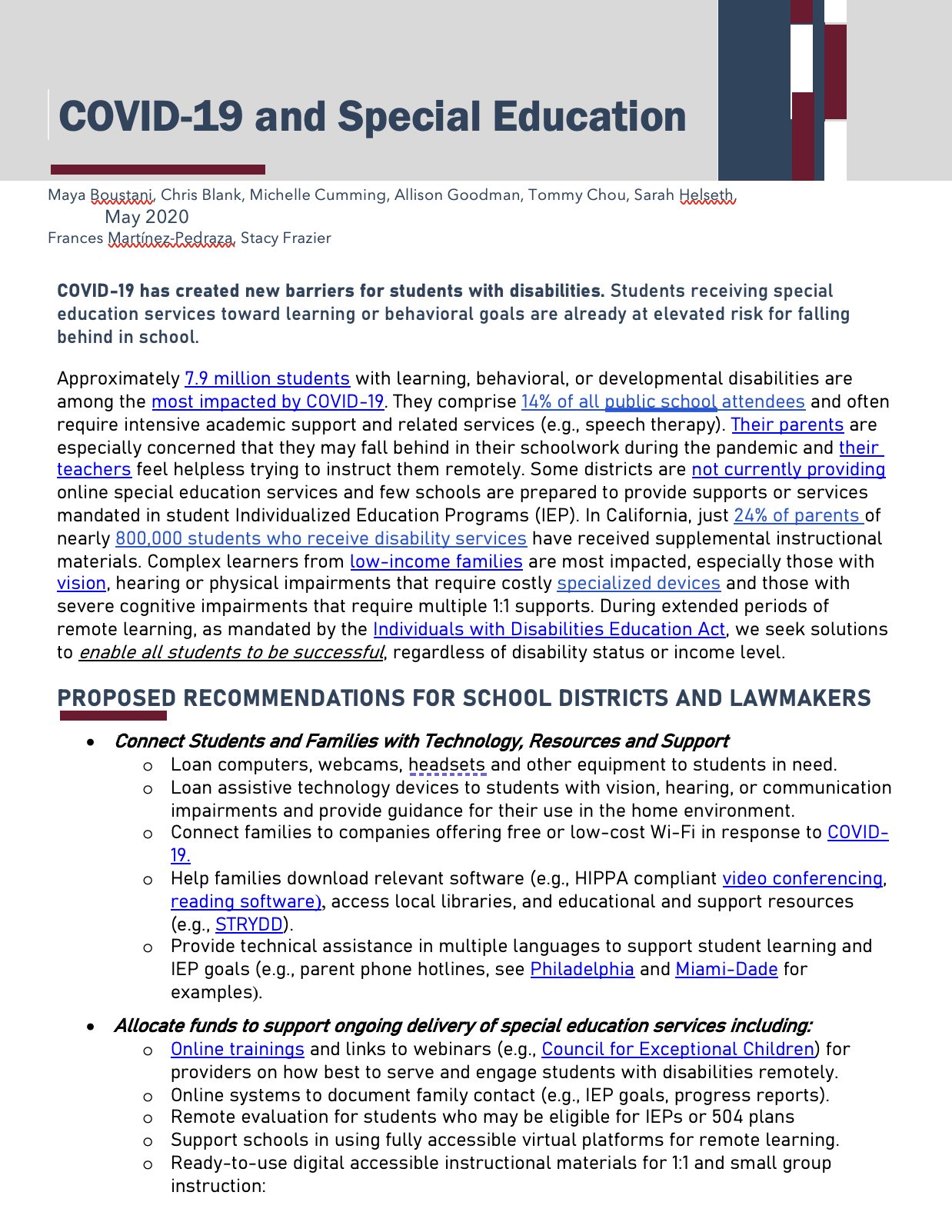
COVID-19 has created new barriers for students with disabilities. Students receiving special education services toward learning or behavioral goals are already at elevated risk for falling behind in school.
Approximately 7.9 million students with learning, behavioral, or developmental disabilities are among the most impacted by COVID-19. They comprise 14% of all public school attendees and often require intensive academic support and related services (e.g., speech therapy). Parents may be especially concerned their students may fall behind in schoolwork during the pandemic and students’ teachers may feel helpless trying to instruct remotely.
Some districts are not currently providing online special education services and few schools are prepared to provide the supports or services mandated in student Individualized Education Programs (IEP). In California, just 24% of parents of nearly 800,000 students who receive disability services have received supplemental instructional materials. Students from low-income families are most impacted by this, especially those with vision, hearing or physical impairments that require costly specialized devices and those with severe cognitive impairments that require multiple 1:1 supports. During extended periods of remote learning, as mandated by the Individuals with Disabilities Education Act, we seek solutions to enable all students to be successful, regardless of disability status or income level.
Proposed Recommendations for School Districts and Policymakers
Consider connecting students and families with technology and resources:
- Facilitate partnerships with organizations that loan devices (e.g., computers, webcams, headsets) to students in need. Students with disabilities may also benefit from being loaned assistive technology devices, paired with guidance for their use in the home environment.
- Connect families to resources (e.g., free/low-cost Wi-Fi) necessary for virtual instruction. Families may also need assistance downloading relevant software (e.g., HIPPA compliant video conferencing, reading software).
- Inform families about online access to local libraries and educational and support resources (e.g., STRYDD).
- Provide technical assistance in multiple languages to support student learning and IEP goals (e.g., parent phone hotlines, see Philadelphia and Miami-Dade for examples).
Increase capacity to support the ongoing delivery of special education services:
- Promote and, if possible, incentivize providers’ attendance in online trainings and webinars (e.g., Council for Exceptional Children) on how best to serve and engage students with disabilities remotely.
- Utilize online systems to document family contact (e.g., IEP goals, progress reports).
- Conduct remote evaluations for students who may be eligible for IEPs or 504 plans
- Support schools in using fully accessible virtual platforms for remote learning (e.g., Nearpod). Also consider modifying homework and tests for students with attentional difficulties (e.g., limit questions per page, indicate places for more frequent breaks).
Consider ready-to-use and/or digitally accessible materials for 1:1 and small group instruction:
- Encourage students to use household items and routines for learning at home.
- Incorporate the use of online books into instruction and activities (e.g., Tumblebook Library).
- Build e-flash cards for supplemental learning via Quizlet or similar websites.
The National Center for Learning Disabilities has posted additional recommendations in their Policy & Practice Series.
The Research-to-Policy Collaboration (RPC) works to bring together research professionals and public officials to support evidence-based policy. Please visit their website to learn more.
Key Information
RPC Website
Research-to-Policy Collaboration
Publication DateMay 1, 2020
Topic Area(s)Education and Child Development, Health
Resource TypeWritten Briefs
Share This Page
COVID-19 has created new barriers for students with disabilities. Students receiving special education services toward learning or behavioral goals are already at elevated risk for falling behind in school.
Approximately 7.9 million students with learning, behavioral, or developmental disabilities are among the most impacted by COVID-19. They comprise 14% of all public school attendees and often require intensive academic support and related services (e.g., speech therapy). Parents may be especially concerned their students may fall behind in schoolwork during the pandemic and students’ teachers may feel helpless trying to instruct remotely.
Some districts are not currently providing online special education services and few schools are prepared to provide the supports or services mandated in student Individualized Education Programs (IEP). In California, just 24% of parents of nearly 800,000 students who receive disability services have received supplemental instructional materials. Students from low-income families are most impacted by this, especially those with vision, hearing or physical impairments that require costly specialized devices and those with severe cognitive impairments that require multiple 1:1 supports. During extended periods of remote learning, as mandated by the Individuals with Disabilities Education Act, we seek solutions to enable all students to be successful, regardless of disability status or income level.
Proposed Recommendations for School Districts and Policymakers
Consider connecting students and families with technology and resources:
- Facilitate partnerships with organizations that loan devices (e.g., computers, webcams, headsets) to students in need. Students with disabilities may also benefit from being loaned assistive technology devices, paired with guidance for their use in the home environment.
- Connect families to resources (e.g., free/low-cost Wi-Fi) necessary for virtual instruction. Families may also need assistance downloading relevant software (e.g., HIPPA compliant video conferencing, reading software).
- Inform families about online access to local libraries and educational and support resources (e.g., STRYDD).
- Provide technical assistance in multiple languages to support student learning and IEP goals (e.g., parent phone hotlines, see Philadelphia and Miami-Dade for examples).
Increase capacity to support the ongoing delivery of special education services:
- Promote and, if possible, incentivize providers’ attendance in online trainings and webinars (e.g., Council for Exceptional Children) on how best to serve and engage students with disabilities remotely.
- Utilize online systems to document family contact (e.g., IEP goals, progress reports).
- Conduct remote evaluations for students who may be eligible for IEPs or 504 plans
- Support schools in using fully accessible virtual platforms for remote learning (e.g., Nearpod). Also consider modifying homework and tests for students with attentional difficulties (e.g., limit questions per page, indicate places for more frequent breaks).
Consider ready-to-use and/or digitally accessible materials for 1:1 and small group instruction:
- Encourage students to use household items and routines for learning at home.
- Incorporate the use of online books into instruction and activities (e.g., Tumblebook Library).
- Build e-flash cards for supplemental learning via Quizlet or similar websites.
The National Center for Learning Disabilities has posted additional recommendations in their Policy & Practice Series.
The Research-to-Policy Collaboration (RPC) works to bring together research professionals and public officials to support evidence-based policy. Please visit their website to learn more.

Key Information
RPC Website
Research-to-Policy Collaboration
Publication DateMay 1, 2020
Topic Area(s)Education and Child Development, Health
Resource TypeWritten Briefs
Share This Page
LET’S STAY IN TOUCH
Join the Evidence-to-Impact Mailing List
Keep up to date with the latest resources, events, and news from the EIC.




